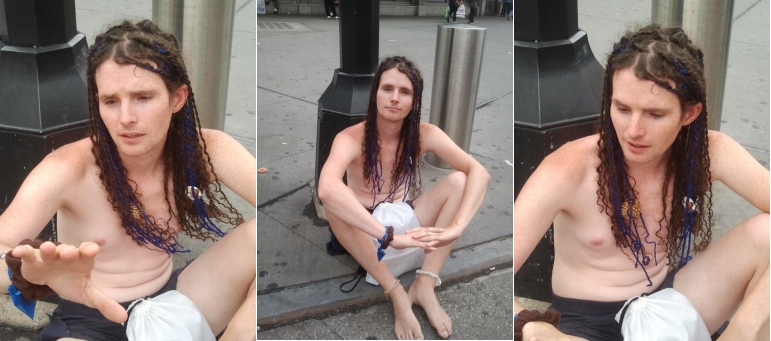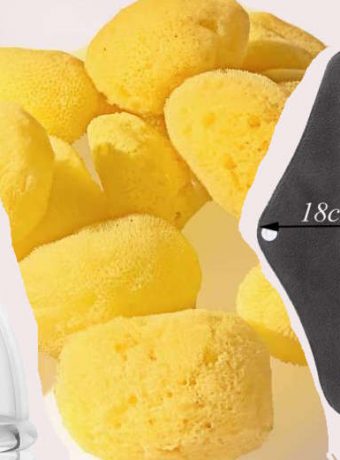
With the story of Rachel Dolezal still fresh in mind, a blond male with hair extensions on the corner of Flatbush and Hanson Ave in Brooklyn, caught my attention. Even though his braids weren’t as on point as the now former president of the NAACP Spokane chapter, I had to ask this young man about his hairstyle. His answer could’ve simply been “O, I just love braids” but it was an answer that lead to a most interesting conversation: “Out of solidarity with my brothers and sisters”, he said.
Out of collective consciousness and solidarity with the struggle of my Black brothers and sisters who are getting a lot of hate these days, he summed up his answer a few minutes later. This was more than I expected so of course I lounged few more questions.
When I asked if he identified as Black he answered yes with a smile then asked if this was about the controversial news story. He swore that even before Dolezal’s story broke he told his friend that he was transracial. This White New Yorker woke up one day and felt that he was Black. He felt immensely connected to Black people’s music, the soul, the culture and even the way Black people move. He felt elevated by Blackness, it was an awakening, a spiritual experience. He said his friend posted Dolezal’s story on her wall and mentioned that he introduced her to the term transracial when he shared this story with her.
Our conversation became even more interesting when I asked if he wanted to be Black. He hesitated for one tiny second and answered “I didn’t say that I only identify as Black.” Then he pointed to his right arm and said that maybe he would like this part of his body, his arm and palm, to be black. The story doesn’t end there.
Even more remarkable was the fact that this man said that he also happened to be transgender. At one point in his life he struggled so hard that he tried to commit suicide because he just wasn’t happy with his sex.
So he was a transgender who wanted a sex change. At the same time he was a transracial who maybe wanted part of his skin to be Black but surely didn’t want a color change. As much as he identified with Black culture he wanted to remain White. Even though I am not a psychologist, in my observation this makes all the difference.
There is nothing wrong with wanting to be part of a different culture than the one you were born into. Isn’t that the main reason why people move out of their hometown?
There isn’t even something wrong with identifying with a different culture than the one you were born into and embracing that other culture. A great example is my former Yoga teacher who was a white man. More than an exceptionally good teacher he was a Yogi who embraced the culture, lived it so much so that knew more about it than anybody I’ve ever met. He wasn’t born Indian or Yogi. He was a White man who learned Yoga, mastered it and made a living teaching it.
In that, Mellisa Harris-Perry does have a point: there is a different ethnic category that can be authentic, is about achievement and not necessarily about race. This doesn’t mean however that an individual who embraces a different culture can also change their race.
There is a big difference between authentically identifying with a culture and lying about your ethnicity. You can identify with something that you are not but you can’t be that something that is not you and there lies the problem.
Maybe people can be transracial in the sense that they identify more with a different race. A transracial person might also be someone who feels comfortable embracing different ethnic cultures. Transracial however becomes an issue when a person identifies with a different ethnic culture than their own and experience it so intense that they feel the need to denounce their own race and background and even lie about it. It is internalized racism and rather than condemning it or joking about it, we need to learn to deal with it.
As the parents of Rachel Dolezal said: they hope she gets the mental help she needs. That is what that whole case comes down to.
There are as many reasons as to why one can authentically consciously embrace another culture as to why one can feel unhappy with their own race.
We all know the stories about little girls like Lupita who pray for lighter skin at a young age because of the dominant beauty standards. We also know of White kids who act or identify as “Black” because it seems so cool. If you ask me all kids go through phases of wanting to be something that they are not, identifying with things different from their usual environment. It’s part of growing up. It’s how we grow closer to our real identity. It’s normal but then there is also the danger of the extremes.
The Rachel Dolezals who do need mental help because they try so hard to be something they can never be that they constantly put up a front and lie about their ethnicity, background and everything necessary to just live the lie. Well if there is one thing she didn’t lie about it is this: Identity is multilayered, and identity is very complicated.
My only hope is that society sees this, acknowledges it and finds a way to deal with the mental issues related to complicated multi levels of transracial and identity.




